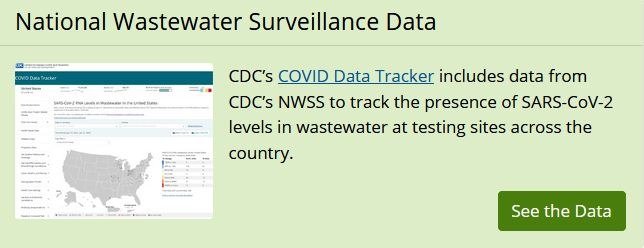Since this comment was queued for today, CDC has announced a vigorous campaign to use wastewater data; more information will be forthcoming. -Kotok

For the first time, the CDC will publish data that looks at how much coronavirus is turning up in the country’s wastewater. Wastewater-based epidemiology has proven to be so reliable that the government has invested millions to create the National Wastewater Surveillance System, a network of 400 testing sites spread across 19 states. It will add this testing data to its Covid-19 dashboard.
Read full story here: https://whdh.com/news/cdc-to-unveil-its-latest-weapon-in-covid-19-detection-wastewater/
Also, see "CDC launches COVID-19 wastewater surveillance dashboard". This was just released Friday and the intro states that more than 34,000 samples have been collected representing 53 million Americans. Story and short video available here: https://abcnews.go.com/Health/cdc-launches-covid-19-wastewater-surveillance-dashboard/story?id=82672272
We continue to watch wastewater testing and laboratory results as a leading indicator of the intensity of the Omicron surge. See “Omicron & the Wastewater Transmissibility Indicator,” https://www.cumber.com/market-commentary/omicron-wastewater-transmissibility-indicator.
Wastewater surveillance told us where Omicron cases were surging before any other indicator could, and now they suggest that Omicron infections in US cities have passed their peak: “Wastewater suggests Omicron is receding in US cities,” https://www.cidrap.umn.edu/news-perspective/2022/01/wastewater-suggests-omicron-receding-us-cities.
That assessment is based on data for 83 cities provided by a Nationwide Wastewater Monitoring Network powered by Biobot Analytics. See their “Nationwide Wastewater Monitoring Network” page at https://biobot.io/data/. Biobot Analytics offers consulting as to how communities or buildings may monitor wastewater for Covid and other pathogens. The Boston Globe profiled this startup in a January 20, 2022, article, “The Cambridge startup tracking COVID in America’s Wastewater,” https://www.bostonglobe.com/2022/01/20/business/cambridge-startup-tracking-covid-americas-poop/.
Biobot Analytics’ private-sector effort seems to be outpacing the CDC’s planned National Wastewater Surveillance System (NWSS). Details about the CDC's system can be seen here: (https://www.cdc.gov/healthywater/surveillance/wastewater-surveillance/wastewater-surveillance.html).

A second data indicator affirms that Omicron cases are receding across cities in the US. Kinsa, a San Francisco company that tracks 2.5 million internet-connected thermometers across the U.S. shows that Americans’ fevers are coming down. See the January 19, 2022, report in The Morning, an emailed daily report from the New York Times. Fevers are not as precise an indicator as wastewater surveillance that can pinpoint a particular variant of a particular virus, but that data is useful, too.
Why is laboratory work on wastewater so important? Because it is a leading indicator of the spread of a virus like Covid or other pathogens that pass through a person’s intestinal tract. Wastewater surveillance can identify the presence of the virus long before symptoms develop and infected people see positive test results. (“Scientists can detect COVID-19 in wastewater weeks before anyone tests positive,” https://www.foxnews.com/us/scientists-detect-covid-19-wastewater-weeks-before-anyone-tests-positive).
The means to test is firmly established; the nature of the test is nonpolitical; and the testing is readily done. Like so many other viruses, SARS-CoV-2 infects through your nose and mouth. Even if it doesn’t reach your lungs, it does go through your digestive system.
Testing samples procured from sewage treatment plants and wastewater and effluent piping and carrying systems yield results accurately, rapidly, and with data accumulated in real time. The data can be tracked daily. For these reasons, using this known and established and reliable method to track Covid’s spread is pure common sense. The technique is used for many types of disease threats.
In a fascinating overview of the admittedly unsavory wastewater testing process and its value, NPR reports, “If there are strands of omicron RNA in that gunk, researchers can identify omicron at concentrations as small as one or two infections out of 100,000 people” (“Poop sleuths hunt for early signs of omicron in sewage,” https://www.npr.org/sections/health-shots/2021/12/09/1062493635/testing-omicron-in-sewage).
Wastewater surveillance turns up novel mutations, giving researchers a clearer picture of how the virus mutates and even an opportunity to identify new variants before cases begin turning up. “Cryptic lineages,” which cannot be matched to known variants in humans, are showing up, for example, in New York City’s wastewater. See “In New York City Sewage, a Mysterious Coronavirus Signal,” https://www.nytimes.com/2022/02/03/health/coronavirus-wastewater-new-york.html.
A recently published wastewater study revealed that Omicron was already present in the US before the able team in South Africa identified the new variant. See Bloomberg’s report, “Omicron’s Spread Through U.S. Cities Is Shown in Wastewater Study,” https://www.bloomberg.com/news/articles/2022-01-20/omicron-s-spread-through-u-s-cities-shown-in-wastewater-study?sref=TG2o5EVv, along with the study itself, “Notes from the Field: Early Evidence of the SARS-CoV-2 B.1.1.529 (Omicron) Variant in Community Wastewater — United States, November–December 2021,” https://www.cdc.gov/mmwr/volumes/71/wr/mm7103a5.htm.
Just as US cities are tracking wastewater, universities are tracking levels of SARS-CoV-2 virus in their sewerage systems to estimate disease spread in dormitories. As early as October of 2020, according to NPR’s findings, more than 65 US colleges were testing wastewater to monitor Covid’s prevalence on their campuses. (“Colleges Testing Wastewater to Find COVID Early,” https://www.webmd.com/lung/news/20201026/colleges-testing-wastewater-to-find-covid-early)
The same concept is applied to industrial complexes. Imagine the information-gathering power of a testing facility in any large institution or, in a place like Florida, in any large condominium complex. So, does your condo track anything from its wastewater system?
A growing number of states, including Idaho, Florida, Colorado, New York, and California, are likewise either undertaking or preparing to undertake wastewater surveillance in a comprehensive and systematic way:
- “Idaho plans to expand wastewater testing for COVID-19,” https://www.boisestatepublicradio.org/news/2021-12-06/idaho-Covid-19-wastewater-testing
- “Florida will use wastewater to track coronavirus cases,” https://wusfnews.wusf.usf.edu/health-news-florida/2021-10-11/florida-will-use-wastewater-to-track-coronavirus-cases’’
- “Sewage water testing provides clues to Omicron spread across US,” https://www.theguardian.com/world/2021/dec/10/sewage-water-testing-provides-clues-to-omicron-spread-across-us
Wastewater lab work is vitally important because it is one of the earliest warning methods we have by which to track disease spread in a community. Investors may want to think about this tool in terms of their decision-making. Would you make portfolio changes if you saw rising or falling Covid numbers in the wastewater laboratory work? Are you even thinking about it or tracking it? Are your consultants and advisors looking at this indicator? In some cases, it is not to be found, because state and local governments don’t have it or are not releasing it.
Policy makers and government need to respond to a different set of questions. The Covid-spread wastewater indicator is right in front of your nose at the local wastewater treatment plant. Or it’s in the pipeline coming out of your organization’s sewerage system. What are you doing to gather information so that you can act more quickly to anticipate disease surges and prevent the evolution of sickness, hospitalizations, and deaths?
We thank the readers who asked us about wastewater. Please feel free to ask your public health folks in your community or region and your state and local governments. Your life and mine may depend on the answer.
Disclosure: During my career, I have been a financial advisor to wastewater treatment government agencies. At times, we had to issue bonds to finance the construction and upgrading of facilities. Part of those issues included the required financial disclosures that accompany the issuance of a public security. I toured my first sewer plant over 40 years ago as part of due diligence visit by a financial institution that was insuring the bond of the sewer plant. Cumberland Advisors does the direct credit review work on such facilities as a part of its portfolio management operations.
David R. Kotok
Chairman & Chief Investment Officer
Email | Bio
Links to other websites or electronic media controlled or offered by Third-Parties (non-affiliates of Cumberland Advisors) are provided only as a reference and courtesy to our users. Cumberland Advisors has no control over such websites, does not recommend or endorse any opinions, ideas, products, information, or content of such sites, and makes no warranties as to the accuracy, completeness, reliability or suitability of their content. Cumberland Advisors hereby disclaims liability for any information, materials, products or services posted or offered at any of the Third-Party websites. The Third-Party may have a privacy and/or security policy different from that of Cumberland Advisors. Therefore, please refer to the specific privacy and security policies of the Third-Party when accessing their websites.
Cumberland Advisors Market Commentaries offer insights and analysis on upcoming, important economic issues that potentially impact global financial markets. Our team shares their thinking on global economic developments, market news and other factors that often influence investment opportunities and strategies.

